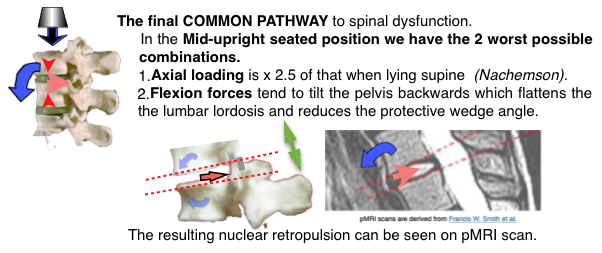 Only a 2Tilt reclined mode addresses all the described adverse ergonomic effects of prolonged sitting which are described below. For a correct fully remediated sitting position …
Only a 2Tilt reclined mode addresses all the described adverse ergonomic effects of prolonged sitting which are described below. For a correct fully remediated sitting position …
- This has to be correctly configured and begs further prerequisites for a truly practical work chair.
- Support is given to the whole length of the body, from head to feet.
- Pressure is distributed widely, mainly from the seat-pan to the Backrest
- Even with the reduced axial loading the lumbar lordosis should be maintained and is best effected by some degree of pelvic (not lumbar) support. This avoids any tendency to backward tilt of the pelvis with stretching of the posterior components. The support should only be sufficient to avoid lumbar flattening when supine, and should preferably not be adjustable so as to avoid excessive lordosis and wrong positioning.
- The kyphotic curve of the thoracic spine is allowed to be exaggerated being a stable area and fully supported. Included with the upper lumbar joints, it extends,over 14 segments and the slight extra flexion at the upper lumbar joints is allowable.
- A correctly placed head/neck-rest is required so that the occupant has no need to move the neck to establish a comfortable task-related visual field. With the pronounced fully supported thoracic curve (kyphosis) the headrest needs to be forward from the backrest. This involves some neck flexion, over several joints, which is supported and and the weight of the head can be off-loaded to the head-rest if the force of the head-rest is directed to the base of the skull and not the back if the head. Freedom of easy movement away from the headrest is easy, if so required.
- In the reclined work position the key board and mouse should rest on or near the lap. This is an ergonomically correct position for the arms and wrists.
- Arm-rests are not an essential requirement of the 2T concept but depend on design and usage.
- The head and leg-lengths are the most variable parts of the human body, so vertical, axial, adjustment of these is essential in the reclined mode. A spring foot exercise system is an advantage for exercise of the calf muscles.
- Apart from this, adjustments should be avoided as far as possible,
- For a fully supported position a leg & foot-rest are essential. In the Okamura solution the chair is lowered so that the heels can rest on the floor or a bar under the desk. In the early 2Tilt ‘prototype1’→ the leg-rest/ seat / backrest/ headrest configuration remains constant (monocoque) and in the upright mode the legs are astride the leg-rest with the feet on the floor. This is probably not practical for an office desk and the leg-rest may have to be retracted or folded down.
- The calf length leg rest, seen in recliners, should be avoided in a 2T chair as compression of the calf can result in Deep Vein Thrombosis (DVT). This may be obviated with recliners which have upholstery and when the legs are in a position at or above the level of the heart.
- In a reclined mode heat and moisture build-up can be a problem. Solutions include a mesh construction or padded slats.
Prototypes
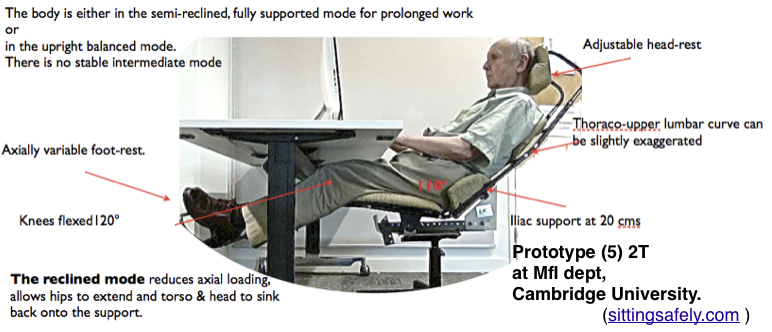 A prototype (p5) was constructed, in the MfI Dept of Engineering in Cambridge, to show the practicality of the 2T concept.
A prototype (p5) was constructed, in the MfI Dept of Engineering in Cambridge, to show the practicality of the 2T concept.
This was the simplest form, based on the original monocoque configuration to illustrate angles and construction.The essential requirements were determined and additional requirements were 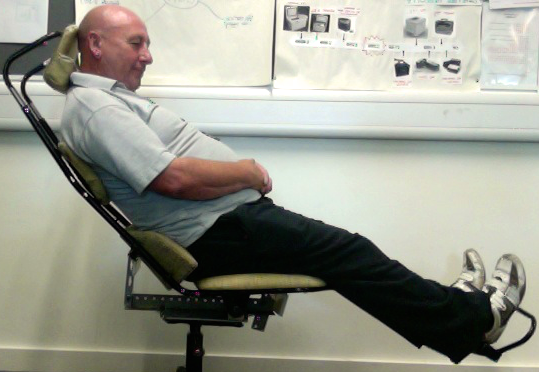 mentioned. It is possible, and likely, that complications and variations can, and will, be made and it is hoped that this study will be a reminder of the essential principles. Students working on this (P5) model found it very comfortable and used it whenever possible. I was amazed to see how they bounced about on what was only a somewhat flimsy prototype.
mentioned. It is possible, and likely, that complications and variations can, and will, be made and it is hoped that this study will be a reminder of the essential principles. Students working on this (P5) model found it very comfortable and used it whenever possible. I was amazed to see how they bounced about on what was only a somewhat flimsy prototype.
About an earlier (P4) prototype, I wrote ‘I found this reclined position very 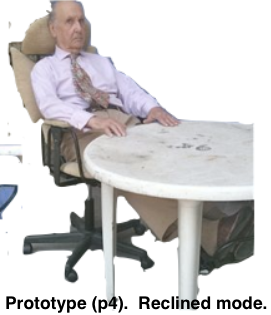 comfortable and adopted it whenever possible. There is no tendency to go to sleep! When viewing the screen I used the head rest but sometimes brought my head slightly forward when typing. Ideally the footrest should be sprung. The thoraco-upper lumber curve could be exaggerated further to allow less flexion at the neck. The 2T chair in the reclined mode is relevant to users who have unusual spinal configuration. HAS. See ☛ ‘Special needs’→
comfortable and adopted it whenever possible. There is no tendency to go to sleep! When viewing the screen I used the head rest but sometimes brought my head slightly forward when typing. Ideally the footrest should be sprung. The thoraco-upper lumber curve could be exaggerated further to allow less flexion at the neck. The 2T chair in the reclined mode is relevant to users who have unusual spinal configuration. HAS. See ☛ ‘Special needs’→
The ‘Tilt in Space’ v ‘reclined systems’ debate
This largely relates to wheel chair patients with major conditions such as spinal cord injuries, muscle diseases, cerebral palsy and head injuries and is hardly relevant to office workstations. The difference is that the TiS has a fixed seat-to-back angle being monocoque as in my p1-5 prototype versions. Cambridge studies showed this to be easily feasible although I prefer the leg-rest retracted in the upright mode unless used in a desk-less system. The reclined systems mode is achieved by opening up the seat-to-back angle and is claimed to increase shear, discussed by Lange, M. L. 2000.
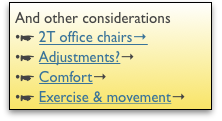 ☛ 2T office chairs→
☛ 2T office chairs→- ☛ Adjustments?→
- ☛ Comfort→
- ☛ Exercise & movement→
Finally check

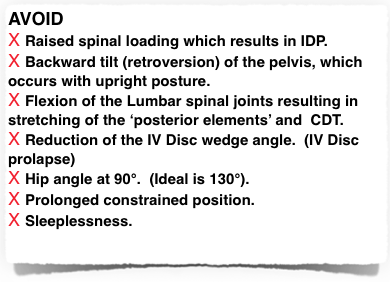 See
See 